We originally posted these 8 Myths in the run-up to International Women’s Day 2014. Here we’ve gathered them all up into one post so you can quickly and easily bust 8 common myths about abortion in Ireland.
Myth #1 Ireland is abortion-free
In partnership with Alliance for Choice Belfast, we bring you:
Truth #1 Ireland is not, never has been, and never will be abortion-free.
Firstly, abortions are sometimes performed legally across the island of Ireland where the woman’s life is in obvious and immediate danger. (Many anti-choice semantic magicians choose not to call abortions in these cases abortions, but that’s a myth for another day.) However, the paper-thin distinction between risk to health and risk to life in Irish abortion law can leave doctors’ hands tied when treating complications in pregnancy. Long-term or permanent risk to the pregnant woman’s physical or mental health can also be grounds for legal abortion in Northern Ireland. 51 abortions were performed legally in Northern Ireland in 2013. It’s not known how many legal abortions are performed in the Republic of Ireland where there the woman’s life is threatened by her pregnancy. Master of the National Maternity Hospital Dr Rhona Mahony’s estimate is ten to 20 per year; Master of the Rotunda Hospital Dr Sam Coulter Smith reckons 20 to 30 terminations are performed.
These are Irish abortions.
Secondly, Ireland’s near-total abortion ban, far from stopping Irish-resident women having abortions, has instead compelled well over 150,000 to travel overseas for safe, legal abortions since 1980. In 2012 alone 3,982 women gave ROI addresses and 905 gave NI addresses when accessing abortions in England and Wales.[4] And these are only the ones we can count. Many more women provide UK addresses at which they are not resident; provide no address at all; or travel to Scotland, the Netherlands or further afield to have abortions. All in all, it’s estimated that at least twelve women leave Ireland every day to access safe, legal abortion services overseas. While these abortions are not performed on Irish soil, the women seeking them are from and/or living in Ireland.
These are Irish abortions.
Thirdly, an inestimable number of women in Ireland now illegally procure abortions in their homes with abortifacient pills ordered online. In 2009 alone Irish Customs seized in excess of 1,200 such tablets. The number of pills seized has fallen in recent years, possibly due to easier access to emergency contraception. (Hint, hint, anti-choicers.) Nonetheless, these figures still probably represent only the tip of the iceberg of the true volume of such pills being imported by people in Ireland: many packages are successfully delivered.
These are Irish abortions.
‘Keep Ireland abortion-free,’ goes a popular anti-choice slogan. Mission impossible.
Myth #2: Abortion causes or increases the risk of suicide, depression, and ‘post abortion syndrome’.
But the truth is much simpler
Truth #2: Women have plenty of feelings after abortion, and when they have real access to safe, legal abortion, they are not more at risk of emotional problems.
It’s possible to regret having had an abortion, possible indeed to experience feelings of regret or loss afterwards. It’s possible to feel a sense of relief and closure after having an abortion. Similarly, it’s possible to regret having placed a child for adoption, having adopted a child, having given birth, not having given birth—or not having had the choice not to give birth. Such is the variety of human experiences and emotions.
However, the notion that most or all women experience regret, anxiety, depression, etc., after having an abortion is not just shaky conjecture but also, according to the highest-quality scientific evidence available, untrue. The American Psychological Association (APA) and the Johns Hopkins University have both carried out separate large-scale reviews of research on abortion and mental health. Both established that the large majority of women don’t regret having chosen abortion. Research by the HSE’s Crisis Pregnancy Programme in 2010 showed that 87% of women in Ireland who had an abortion said it was ‘the right outcome’ for them.
Significantly, restricting women’s access to abortion does provoke feelings of depression and anxiety and does increase the risk of suicide in pregnancy. This burden is merely exacerbated by the isolation and stigmatisation felt by those compelled to travel overseas for access to safe, legal abortion services.
‘Post-abortion syndrome’, a condition imagined and coined by American anti-choice campaigner Vincent Rue, is not recognised by any medical or psychological organisation.[1] ‘PAS’ is listed neither in the Diagnostic and Statistical Manual of Mental Disorders nor the World Health Organization’sInternational Classification of Diseases, arguably the two most authoritative manuals that classify mental disorders. Why not? Because it doesn’t exist.
[1] See, for example, Nada L. Stotland, ‘Abortion and psychiatric practice’, Journal of Psychiatric Practice, 9 (2003), 139–49; American Psychological Association, ‘APA research review finds no evidence of ‘post-abortion syndrome’ but research studies on psychological effects of abortion inconclusive’ [press release], January 18 1989.
Myth #3 Criminalising abortion ensures a low abortion rate.
But the truth is much simpler
Truth #3: Women have abortions regardless of whether the procedure is legal, and restrictions just make abortions less safe.
Restrictive abortion laws are not associated with lower abortion rates. In fact the statistics point to a correlation between restrictive abortion laws and higher abortion rates. Across Africa and Latin America, for example, where abortion is illegal under most circumstances in the majority of countries, the abortion rate is 29 and 32 abortions, respectively, per 1,000 women of childbearing age. In Western Europe, where abortion is generally legal on broad grounds, the abortion rate is 12 per 1,000, the lowest subregional rate in the world.
Women have always sought and chosen abortion, regardless of its legal status, sometimes with tragic results. In Ireland’s darker days many had recourse to backstreet abortion providers. Birth concealment and infanticide were also common in Ireland before sexual health education, contraception and abortion (by way of the stopgap of England and Wales) became more easily accessible.
Assuming that is a goal, what does lower abortion rates then, if not legislative restrictions and criminalisation?
Measures that are preventative as opposed to punitive contribute to reducing the rate of unintended pregnancies and, concomitantly, the abortion rate. Two prime examples are widespread access to affordable or free contraception, including emergency contraception, and comprehensive, unbiased sex education in schools at an appropriately early age.[1] These form part and parcel of a pro-choice vision of reproductive rights and sexual health awareness.
Ironically, many of the most vociferously anti-abortion groups and individuals also oppose these very measures that are proven to lower the abortion rate.
Women in poverty are significantly overrepresented among abortion patients. It follows that the provision of resources that create an environment in which it will be easier for a woman to decide to take a pregnancy to term also contribute to reducing the abortion rate: (compulsory) maternity and paternity leave and benefits; affordable or free public childcare; cash grants and tax benefits for women with dependent children; affordable or free postnatal health care; and flexibility with regard to flexitime and other job-sharing and part-time work arrangements.
If criminalising and restricting access to abortion doesn’t reduce the abortion rate, what does it do?
As we’ll find out further on in this series, legislative restrictions on abortion correlate with abortions being performed at later gestational ages partly because of delays incurred by the necessity of travel. Such restrictions also increase the percentage of unsafe abortions. In 2008, the most recent year for which the World Health Organization has published the numbers, unsafe abortions accounted for 13% of maternal deaths globally: 47,000 deaths.
This is where England and Wales come to Ireland’s rescue. And this is what makes Ireland’s near-total abortion ban such a hypocrisy and such an insult to women: it’s primarily symbolic. Abortion is available to women in Ireland—either illegally on home soil or legally across the sea. The Eighth Amendment merely makes it difficult for well-off women to access safe, legal abortion and even more difficult for less well-off women.
Our laws should keep us healthy and happy, not tow the line of a noisy minority. Criminalising abortion doesn’t stop abortion. It stops women.
[1] See, for example, Rachel K. Jones and Jenna Jerman, ‘Abortion Incidence and Service Availability in the United States, 2011’, Perspectives on Sexual and Reproductive Health, 46 (2014) (forthcoming); Cicely Marston and John Cleland, ‘Relationships between contraception and abortion: a review of the evidence’,International Family Planning Perspectives, 29 (2003), 6–13; Evert Ketting and Adriaan P. Visser, ‘Contraception in the Netherlands: the low abortion rate explained’, Patient Education and Counseling, 23 (1994), 161–71.
In partnership with Re(al)-Productive Health, we bring you:
Myth #4 Making Abortion more widely available will result in its use as a method of Contraception/Birth Control.
But the truth is much simpler:
Truth #4: There is no credible evidence that if abortion was more accessible that sexually active people would use abortion as a method of birth control.
Whiff of holier-than-thou misogyny from this one? We think so too.
First of all, abortion, by definition, can’t be used as a method of contraception: abortion occurs after conception.
Semantics aside, in the absence of any credible supporting evidence, there’s nothing to suggest that if abortion access is improved, sexually active people will suddenly ditch hormonal and/or barrier contraceptives in favour of abortion as a primary method of birth control (such as abortion can even be considered a method of birth control).
For one, abortion is, compared to contraception, potentially a far more troublesome and invasive way to go about not having a child. In many countries, even those in which abortion is legal, abortion services can also be difficult to access and/or expensive. Of course, the Abortion Rights Campaign advocates the availability of free, safe, legal abortion. The point remains, though, that the privacy and convenience alone of contraception make this myth more than a shade counter-intuitive.
And the notion that improved access to abortion will reduce the use of contraception is a myth. A recent Australian study found that the majority of women (in South Australia) seeking an abortion were pregnant despite contraceptive use and that the vast majority of the remaining women still hadn’t intended to become pregnant.
Thing is, no method of contraception is 100% reliable, and contraception may not always be used with flawless effectiveness and regularity. Furthermore, in Ireland emergency contraception (EC) can often prove prohibitively inaccessible and expensive.
Those accessing EC in Ireland also often come up against condescension and negative judgement. A study conducted by Re(al)-Productive Health shows that 17% of survey respondents had paid more than €35 for EC, with just 11% having paid less than €15. 23% of respondents identified the consultation process as negative; 28% felt that the pharmacist involved displayed negative judgement towards them, with terms such as ‘patronising’, ’embarrassing’, ‘awkward’, ‘unnecessary’ and the statement ‘I felt judged’ used by some participants.1 More worryingly, under Principle One of the Pharmaceutical Society of Ireland’s Code of Conduct for pharmacists, pharmacists may refuse to dispense EC if it contradicts their ‘personal moral standards’.
As the Australian study shows, women who don’t wish to become pregnant may still do so because of, for example, rape or an abusive partner who controls contraceptive use or sabotages contraceptives; substandard sexual health education or access to information; falsely believing oneself to be infertile; cultural bans; human error, etc.
An unplanned pregnancy is a potentially distressing situation for any woman. The presumption that women don’t think long and hard about how to prevent, deal with and potentially terminate a pregnancy is not borne out in any research, anecdotal or scientific. It’s a presumption founded on a distrust of women to have the capacity to make informed and responsible choices about their lives and health. When women have full reproductive choices, however, they do what makes economic, personal, moral and social sense for their own lives.
It’s only in countries that have restricted or no access to contraception that abortion has been shown to become a primary method of controlling one’s reproduction. Romania in the late 1980s, for example, after 25 years of bans on contraceptives and abortion services enacted under Nicolae Ceauşescu’s Government, still had the highest abortion rate in Europe.
Abortion as a primary method of birth control? Technically impossible, statistically improbable, frankly insulting.
1 ‘Accessing emergency contraception ‘behind the counter’ in pharmacies in Ireland’ (forthcoming).
Myth #5 Making Abortion more widely available will result in many late term abortions
But the truth is much simpler:
Truth #5: Where abortion is prohibited or difficult to access, the chances are higher for late-term abortions to occur.
It’s important first of all to clarify what we mean when we talk about ‘late-term’ or ‘later-term’ abortions. Indeed there’s no absolute medical consensus on what constitutes a late-term abortion. Some categorise abortions at, for example, sixteen weeks’ gestation as late-term, even though this is many weeks before any possibility of viability. Indeed fetal viability is often invoked in debate surrounding the designation ‘late-term’. However, the chances of viability are unique to each pregnancy and subject to a whole host of variables, so we’re still faced with a blurred line.
Two other very important questions: who and why? Who are the women who seek late-term abortions? And why do they seek them? If we don’t listen to the women in these situations, it goes without saying that we will likely never understand their decisions.
A survey conducted in the United States in the late 1980s among women seeking late-term abortions found that 48% of them had found it difficult to make arrangements for an earlier abortion. A study last year confirmed that difficulties in accessing abortion are still a primary reason for women seeking later-term abortions. It also found that legislative restrictions on abortion disproportionately affect young women and women with limited financial resources. In other words, later-term abortions are sought where earlier-term abortions are unavailable or difficult to access. This shows a counterproductive hypocrisy at the heart of ongoing efforts by the Republican Party and anti-choice campaigners in the US to chip away at Roe v. Wade (the Supreme Court decision that legalised abortion in the US) with unnecessary and unjustifiable state restrictions on abortion. Such restrictions are actually a prime reason for the occurrence of later-term abortions as women are compelled to scrimp and save and travel across vast swathes of the US for abortion access.
Ireland’s case is similar. An Irish Times front-page article last year revealed that women travelling from Ireland to England and Wales for abortion services are consistently more likely than UK residents to undergo the procedure at a later fetal gestational age. This increased proportion of later-term abortions among women arriving from Ireland is hardly surprising. Women in Ireland who are compelled to travel overseas to access safe, legal abortion services must arrange travel, accommodation, the procedure itself, time off work, childcare, etc., and save the money required for these arrangements. This takes time, particularly for less well off women. This fact, as in the case of the US, underscores a fundamental futility and hypocrisy in Ireland’s abortion laws and the vain anti-choice drive to ‘keep Ireland abortion-free’: the Irish solution to abortion, far from reducing the abortion rate, results in all likelihood in an increase in later-term abortions.
Now, let’s take a look at the numbers. Take our closest neighbours and most significant proxy reproductive rights providers: in England and Wales only 2% of abortions in 2012 occurred at or over 20 weeks’ gestation. An abortion at 20 weeks, roughly halfway through the second trimester and still before any possibility of viability, most likely wouldn’t even constitute a late-term abortion in most people’s eyes. Incidentally, many of the most catastrophic fetal anomalies can’t be diagnosed before 20 weeks’ gestation. This alone shows the unworkability and injustice of bans on late-term abortions. In short, late-term abortions are rare; late-term abortions not performed due to a threat to the woman’s life, a serious threat to her health or a fatal fetal abnormality are exceptionally rare and likely chosen or necessary due to other difficult circumstances.
Practical access to abortion correlates with earlier-term abortions. But late-term abortions are still necessary. Isolating late-term abortions to seek to justify criminalising or restricting access to abortion ignores the very valid reasons late-term abortions may be required and is, besides, counterproductive.
The decision whether or not to have an abortion should be left to the woman’s own conscience, in consultation with her health-care providers. Late-term abortions are no exception.
‘As early as possible, as late as necessary,’ goes a popular pro-choice maxim. The Abortion Rights Campaign works to try to make both parts of that maxim a reality.
For further insight into the women who seek late-term abortions and the medical teams who provide them, see Martha Shane and Lana Wilson’s documentary film After Tiller.
Today, in partnership with AIMS Ireland, we bring you:
Myth #6: Ireland, without abortion, has the lowest maternal mortality rate in the world / Ireland, without abortion, is the safest place in the world for pregnant women.
But the truth is much simpler:
Truth #6: Ireland’s Maternal Mortality Rate (MMR) is roughly average for a developed country. In fact, many countries providing women with access to safe and legal abortion report below-average MMRs.
The mother of all anti-choice myths during debate surrounding last year’s abortion legislation. Even if it were true (it’s not), it would still be irrelevant.
A combination of cherry-picked statistics and the presupposition of a nonexistent correlation between restrictive abortion laws and lower maternal mortality rates makes up the foundation of this non-argument. The proverbial cherry comes courtesy of Maternal Mortality in 2005, a World Health Organization (WHO) report that gathered statistics on MMRs globally in that year. Ireland’s was a conspicuously implausible one per 100,000 live births. Or was it?
The authors of the study prefaced their findings with three significant caveats concerning the data collection process, which are worth quoting at length:
[I]t is difficult to measure accurately the levels of maternal mortality in a population – for several reasons. First, it is challenging to identify maternal deaths precisely – particularly in settings where routine recording of deaths is not complete within civil registration systems, and the death of a woman of reproductive age might not be recorded. Second, even if such a death were recorded, the woman’s pregnancy status may not have been known and the death would therefore not have been reported as a maternal death even if the woman had been pregnant. Third, in most developing-country settings where medical certification of cause of death does not exist, accurate attribution of female deaths as maternal death is difficult. Even in developed countries where routine registration of deaths is in place, maternal deaths may be underreported, and identification of the true numbers of maternal deaths may require additional special investigations into the causes of deaths.
The honesty and restraint shown by the authors in these concessions is unfortunately lacking in those who judiciously extract from the report only the information favourable to their own ideological bias. The phenomenon of under-reported MMRs in developed countries has further been widely documented over the past two decades in medical journals in Ireland and internationally. All three difficulties raised above go some way towards explaining the supposed peerlessness of Ireland’s MMR as reported in 2005: it was determined with reference to crude Central Statistics Office data alone.
In 2009, four years after the publication of the WHO study, Maternal Death Enquiry Ireland (MDE Ireland) was established. It set out more thorough processes and criteria for gathering and analysing maternal mortality data, bringing Ireland at last into line with accepted best practice internationally. MDE Ireland’s report for the years 2009–11 rectified Ireland’s under-reporting and showed the national MMR to be in fact roughly average (eight per 100,000 maternities) for a developed country.
Now, even if Ireland were the world leader in maternal care, the suggestion by anti-choice voices that legislative restrictions on abortion contribute to lower MMRs would still be thoroughly baseless. Many countries with comparatively liberal abortion laws report below-average MMRs, even taking into account under-reporting. The MMRs of Norway and Sweden, for example, where abortion is effectively available ‘on demand’, are both slightly lower than Ireland’s.
What’s more, the MMR of a developed country is usually a single-digit figure or very low double-digit figure per 100,000 maternities. The incidence of maternal death in the developed world is so rare and subject to so many variables and external factors as to render comparison with a view to crowning a leader in maternal care based on MMRs alone meaningless.
Conversely, in many less-developed countries where termination of pregnancy is illegal and access to safe, legal abortion services in neighbouring jurisdictions is unavailable, unsafe (‘backstreet’) abortions do raise MMRs. In such countries the provision of safe, legal abortion services by trained professionals in medically appropriate environments would contribute to a reduction in MMRs towards the developed-world average.
It may take a rummaging through the relevant medical literature and a more thorough reading of the small print before this myth’s shoddy architecture gives way. But when it does give way it falls to pieces.
Of course, MMRs have nothing to do with whether or not women are happy or healthy, and it goes without saying that we should aim higher than merely stopping women dying. Women need full reproductive rights, including access to safe, legal abortion, and good-quality maternity care.
Today, in partnership with Doctors for Choice, we bring you:
Myth #7: Abortion causes/increases the risk of infertility
But the truth is much simpler:
Truth #7: There is no increase in infertility when women have safe, legal abortions.
There is no reliable evidence to support the claim that undergoing a safe (legal) abortion hinders a woman’s ability to become pregnant again. Nevertheless, this myth persists in anti-choice scaremongering efforts and is, along with other medical disinformation, a favourite of self-appointed ‘counsellors’ in rogue crisis pregnancy agencies.
Many proponents of this myth suggest that surgical (as opposed to medical) abortions involve the use of sharp instruments that can tear the tissue of the cervix or uterus and cause infection. However, the instruments used in surgical abortion procedures nowadays, particularly in early surgical abortions (by far the most common), are mostly purposefully blunt and, of course, sterilised. All medical procedures carry risks, but the risk of any cervical or uterine damage from legal abortion is minute.
Women who undergo safe, legal abortions by health-care professionals in appropriate medical environments are not at any increased risk of infertility. Comprehensive reviews of the data show that a suction aspiration procedure in the first trimester, for example, poses virtually no risk to future reproductive health. Early medical abortions are even safer—in fact at least ten times safer than childbirth.
Conversely, unsafe (backstreet) abortions can carry significant risks, including infection due to unsterilised equipment and dangerous techniques. Such infection can lead to infertility, particularly if the infection goes untreated. Women in such circumstances will often not present to medical professionals for appropriate aftercare for fear of prosecution because of punitive abortion laws. The possible fourteen-year jail sentence written into last year’s abortion legislation for someone who procures an abortion outside of the law’s draconian limits is, to say the least, deeply unhelpful in this regard.
Of course, every medical procedure carries some degree of risk, abortion being no exception to this rule. The various methods of legal abortion, however, are among the safest medical procedures around.
Decriminalising abortion is vital to safeguarding women’s reproductive health by reducing the risks associated with unsafe abortion.
Myth #8: Ireland is ‘pro-life’ (because it’s a Catholic country)
But the truth is much simpler:
Truth #8: Being Catholic does not mean you are anti-abortion. At least 150,000 women have travelled from Ireland for an abortion in the last 30 years.
With the signing into law of last year’s Protection of Life During Pregnancy Act, Ireland still has, along with Malta, the most restrictive abortion laws in Europe.
The people of Ireland, however, have repeatedly and increasingly shown their support for wider access to abortion in Ireland. This change in opinion on abortion since the signing into law of the Eighth Amendment in 1983 has been remarkable. According to last year’s Ipsos MRBI poll in the Irish Times, the overwhelming majority of people in Ireland now support a woman’s right to choose abortion at least in the cases of risk to life (89%), risk to health (78%), fatal fetal abnormality (83%) and rape and abuse (81%).
With the possible exception of cases of fatal fetal abnormality (legal opinion differing here), legislation validating current Irish opinion on abortion is impossible without repeal of the Eighth Amendment.
The only recent opinion poll that has shown a supposed majority in favour of ‘constitutional protection of the unborn’ was one commissioned by the Pro Life Campaign (PLC). (Note that favouring such constitutional protection would not be in any way incompatible with favouring wider access to abortion, yet the PLC framed this poll as contradicting the Irish Times poll, which asked a completely different set of questions.) Let’s leave aside any consideration of the potential impartiality of a poll commissioned by a group with vested interests in the abortion debate and look at the questions asked.
Q1. In current medical practice in Ireland, the doctor treats the expectant mother and her baby as two patients and does his/her best to safeguard both in a crisis situation. Do you consider that this practice should be protected and safeguarded by law or not?
Q2. Are you in favour of, or opposed to constitutional protection for the unborn that prohibits abortion but allows the continuation of the existing practice of intervention to save a mother’s life in accordance with Irish medical ethics?
Problem 1: These are leading questions padded with emotionally loaded motherhood-and-apple-pie best-case scenarios and presuppositions of medical consensuses that gloss over the lack of clarity (then as now) in Irish abortion law. ‘What marks these findings out from other research,’ remarks Caroline Simons of the PLC, ‘is the way important ethical distinctions are clarified for the benefit of respondents.’ How thoughtful! But what if respondents disagree with these positively Orwellian PLC-sanctioned ‘ethical distinctions’? (The distinction underlying the second question has no currency in modern medicine—another myth for another day.) ‘No, but…’ or ‘yes, but…’ not being available as answers, it’s perhaps best to leave the ‘ethical distinctions’ to the individual respondent and just ask the questions—as the Irish Times poll did.
Problem 2: The respondent is asked to answer either ‘yes’ or ‘no’ (or claim no opinion) to double-barrelled questions: ‘Do you consider […] or not?’; ‘Are you in favour of, or opposed to […]’ The second question is arguably quadruple-barrelled: a double-barrelled question about two distinct elements of Irish medical ethics (‘protection for the unborn’ and ‘intervention to save a mother’s life’). Confused yet? We don’t blame you: this is staggeringly poor polling methodology.
All in all it’s perhaps little wonder that the results of the PLC’s poll differ drastically from those of every other recent Irish opinion poll on abortion.
Over 30 years have passed since the 1983 ‘pro-life’ referendum. The youngest voters, the eighteen-year-olds, in 1983 are now 48 or 49 years old. Since 1980 well over 150,000 women are known to have voted with their feet and travelled overseas for abortion services. The results of four separate referenda since 1983 have also shown that the majority in Ireland support wider access to abortion. (Of course, the results of these referenda are frequently misrepresented by anti-choice voices. Again, another myth for another day.) New generations are now getting active, singing songs, writing poetry, organising, marching, making their voices heard and instigating and advancing real change because Ireland wants and needs safe, legal abortion.
The false notion of a ‘pro-life’ majority derives in many instances from the fact that Catholicism is the dominant religion in our part of the world. However, a Catholic identity and a pro-choice position are not mutually exclusive, as Catholics for Choice articulately point out.

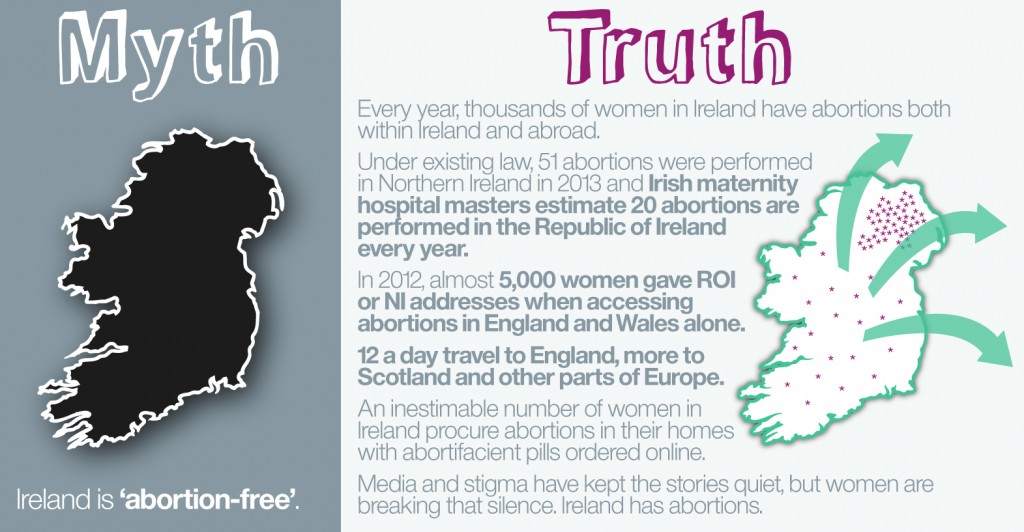
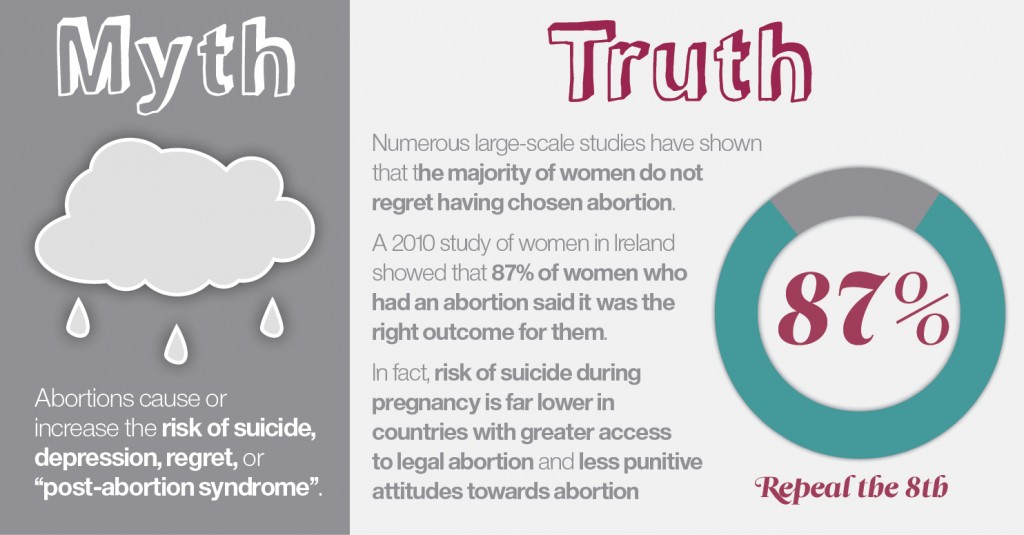
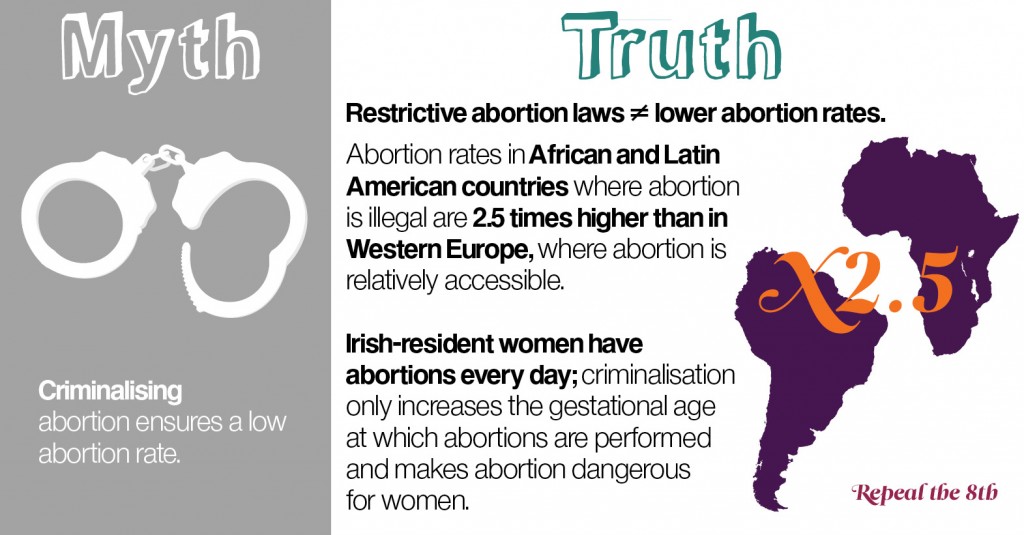
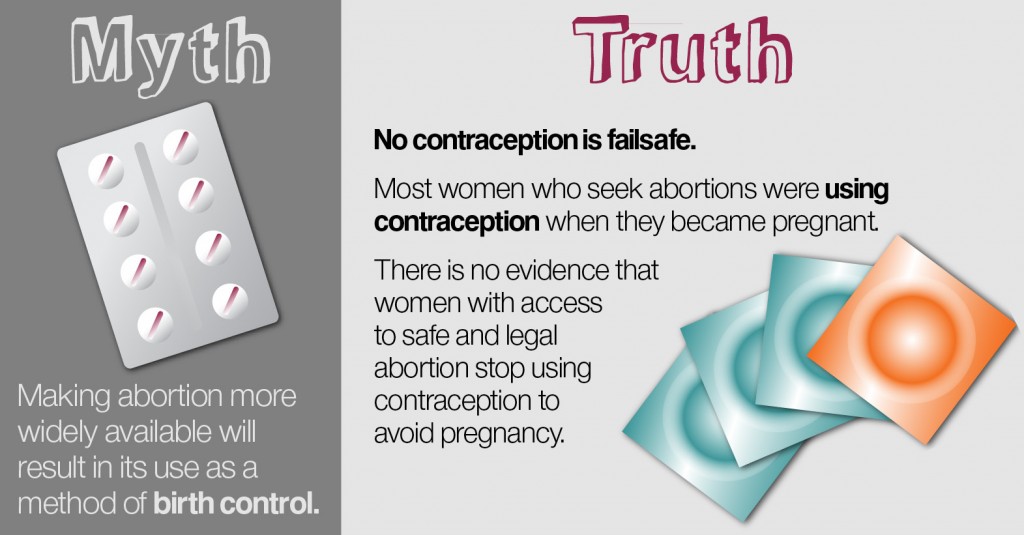
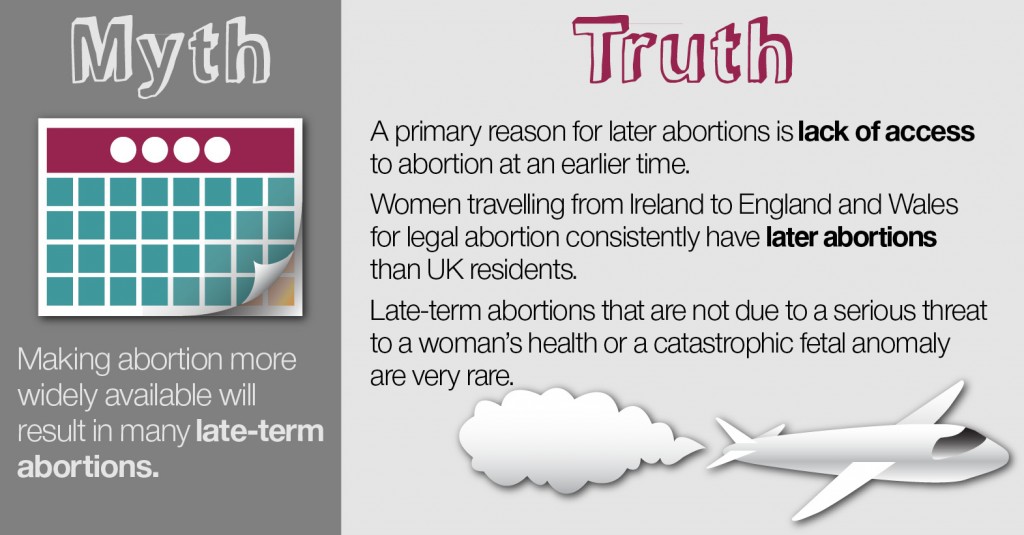
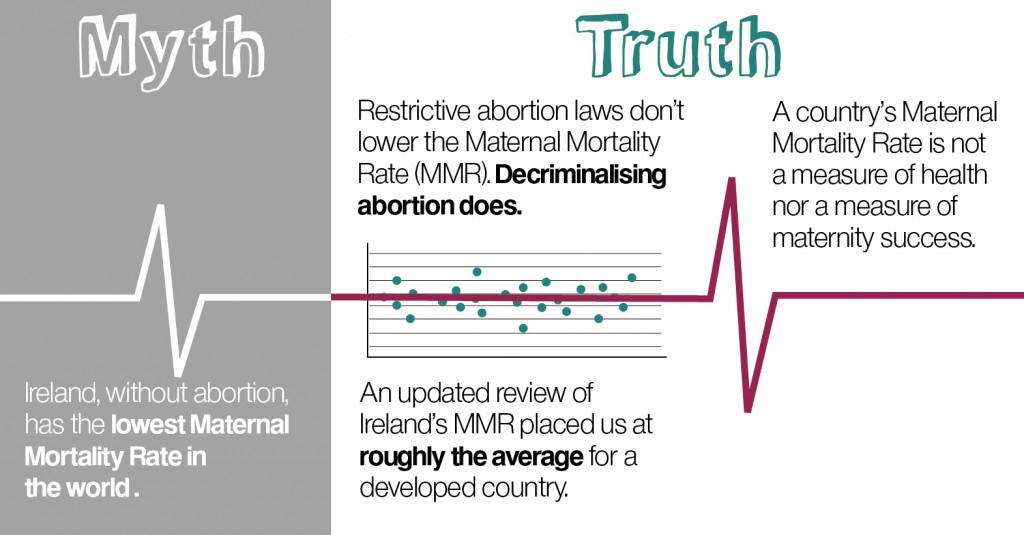
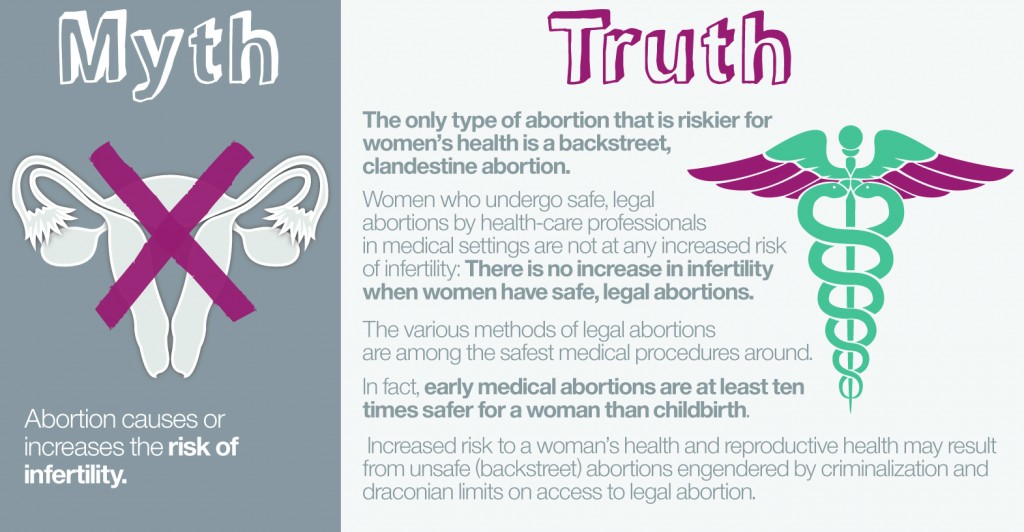


I’d like to see you address the question of whether it is more dangerous to have an abortion or undergo childbirth. Pro-choice people make the claim that it is riskier to bring a pregnancy to term than to have an abortion, while “pro-life” people counter that by claiming that it’s a myth built on misleading/misinterpreted data (of course, that has nothing to do with whether women ought to be able to make that choice and take those risks for themselves, and the fact that abortion is of course riskier to life and health when illegal and unregulated).
https://www.ncbi.nlm.nih.gov/pubmed/22270271
Here is a study about abortion vs childbirth. They simply looked at the number of deaths.
Quoting it
RESULTS:
The pregnancy-associated mortality rate among women who delivered live neonates was 8.8 deaths per 100,000 live births. The mortality rate related to induced abortion was 0.6 deaths per 100,000 abortions. In the one recent comparative study of pregnancy morbidity in the United States, pregnancy-related complications were more common with childbirth than with abortion.
CONCLUSION:
Legal induced abortion is markedly safer than childbirth. The risk of death associated with childbirth is approximately 14 times higher than that with abortion. Similarly, the overall morbidity associated with childbirth exceeds that with abortion.
If it’s safer for a pregnant woman to have an abortion than continue to full term, surely that in itself gives her a strong case to get one, if the amendment is repealed? I mean if a first-time mother-to-be is scared or worried about the process of giving birth, particularly if the pregnancy is unplanned, is it not the obvious choice?
To date Irish male dominated politics has all been the older brainwashed religious generation shouting down the younger generation on most issues. Our very own Catholic Taliban.
A discussion needs to be had regarding the role of patriarchy in Ireland.
Secondly, it became obvious to me a decade ago that right wing American anti-abortion groups had infiltrated the Irish referendum debates and were not only influencing but deliberately stirring up extreme emotional responses with their online posting/shaming videos of women who had “repented” after experiencing abortions.
I’m not sure how this second issue could be addressed.
It would be nice if the current generation of young Irish men would stand up for Irish women in a way that their predecessors did not…
Is there any way this can be made into a pamphlet and that I can have a few of them??
I know a few people who believe ridiculous outdated ideas about abortion and I’d like to have proven facts and stats when I’m talking to them about it.
Haven’t come across any pro-choice canvassers yet, so haven’t been given any handy material.
If there are such existing copies of this kind of material, how can I get it?
A few more uncomfortable truths for pro life voters:
Why is abortion illegal? The aim is to minimise the number of abortions by making it as hard as possible to have an abortion. The hope is that women with crisis pregnancies will be put off by the hassle of travelling abroad, and will continue with the pregnancy instead.
It’s only when standing outside an abortion clinic that the enormity of the decision to abort hits home. If the woman is having doubts, and the abortion clinic is only a few streets from home, then no problem – the woman is free to go home, sleep on it, maybe return, maybe not. For Irish women today, when they arrive at the UK abortion clinic, there’s no going back. They’ve paid for their airfare, their accommodation, the procedure cost, they’ve taken time off work, lied to family, friends, bosses, co-workers. This must lead to needlessly high abortion rates and high levels of regret among Irish women.
If we legalise, wouldn’t there be higher abortion rates, like in England?
Ireland’s abortion rate should be by far the lowest in Europe. But it’s not much different to rates in Belgium, Netherlands, Austria, Switzerland. Public opinion and political will favour minimising abortion in these countries, just like Ireland. There is no such political will in England, public opinion there has not made an issue of abortion rates.
How do we keep abortion rates low?
We get abortion statistics from the NHS, classifying by county. We know the abortion rate in Co Louth, but for all we know, it’s twice as high in Drogheda as Dundalk. Legalisation will allow us to collect our own statistics, and identify and address any abortion hotspots.